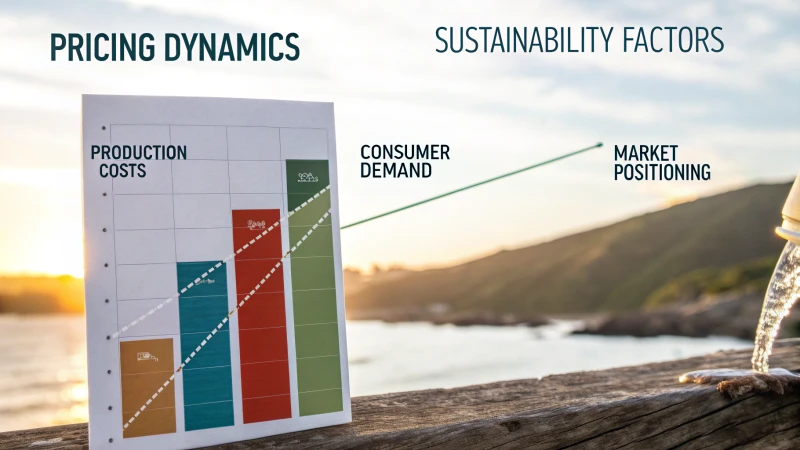
Imagine the impact of wood price swings on your favorite eco-friendly cutlery brand.
When wood prices fluctuate, they shake up the disposable wooden cutlery industry by influencing production costs and supply chain dynamics. These shifts in raw material expenses can lead to higher prices for finished products, affecting both suppliers and consumers.
Navigating these price changes is crucial for businesses like mine. It's not just about rising costs; these fluctuations offer a chance to innovate and push for sustainability. I've seen how companies that adapt quickly can turn these challenges into opportunities, leading to more efficient production and eco-friendlier products. Let's explore strategies that can help us thrive amid these market shifts.
Wood price fluctuations directly impact cutlery production costs.True
Changes in wood prices lead to variable production costs in the industry.
Higher wood prices decrease sustainability efforts in cutlery.False
Higher costs can drive innovation towards more sustainable alternatives.
Why Do Wood Prices Fluctuate So Much?
I remember when I first noticed how unpredictable wood prices could be, a realization that hit hard when planning my latest project. What causes these wild swings in cost?
Wood prices fluctuate due to complex factors like supply chain dynamics, environmental regulations, global demand, and economic conditions. Understanding these can help manage market unpredictability.

Navigating Supply Chain Dynamics
Imagine planning a big event only to find out the main roads are closed—frustrating, right? That's what happens when disruptions hit the wood supply chain. From the forest to your doorstep, any hiccup in harvesting, processing, or transport can send prices soaring1. Just like a last-minute detour adding miles to your journey, fuel costs or strikes can suddenly hike up expenses.
Tackling Environmental Regulations
I once had to switch gears in the middle of a project due to new environmental laws. Stricter regulations can restrict logging, shrinking supply and pushing prices up. Embracing sustainable practices is noble but often comes with a price tag as higher standards demand more costly processes.
| Regulation Type | Impact on Prices |
|---|---|
| Logging Bans | Increases |
| Sustainable Certification | Higher Costs |
Global Demand and Economic Conditions
Think of the times when everyone wants the same trendy gadget. The global wood market is similar; booming construction in places like China and the U.S. drives demand and prices2. Conversely, during economic slumps, prices might drop as demand wanes, much like post-holiday sales.
Weather Events and Natural Disasters
Living through stormy seasons taught me how nature can be unpredictable. Hurricanes or wildfires can devastate forests, limiting timber supply and spiking prices as if overnight. Even without disasters, changing climates can stunt tree growth, affecting future availability.
Additionally, climatic conditions3 can affect growth rates,
impacting long-term supply.
Innovations and Market Trends
Remember how smartphones changed everything? Technological leaps in wood processing or new uses—like those amazing wooden skyscrapers—can ignite demand and alter pricing landscapes. Just as trends shape fashion seasons, they also steer wood market dynamics.
Emerging trends like wooden skyscrapers are a testament to the evolving market's potential impact on pricing dynamics4.
Transportation strikes affect wood prices.True
Strikes disrupt the supply chain, causing price increases due to delays.
Weather events rarely impact wood prices.False
Natural disasters reduce timber availability, driving prices up.
How Do Changing Wood Prices Influence Production Costs?
Have you ever wondered how the rise and fall of wood prices can turn a business plan upside down? Let me take you through the twists and turns that these changes bring and how you can steer through them with confidence.
When wood prices change, production costs are directly impacted. These fluctuations alter raw material expenses, disrupt budgeting, and shake up supply chain dynamics. Adapting your business strategies to these shifts is crucial for maintaining stability and success.

I remember the first time I had to deal with a sudden hike in wood prices. It felt like the ground shifted beneath my feet. I was working on a project that relied heavily on wooden materials, and those numbers on paper quickly translated into real-world challenges.
The Direct Impact of Wood Price Fluctuations
Wood is not just a commodity; it’s a cornerstone for industries ranging from furniture production5 to construction. Imagine waking up to find out that your main material has doubled in price. Suddenly, you’re faced with soaring expenses that eat into your profit margins. But there’s a flip side—when prices drop, the initial relief can quickly turn sour if it hints at a slump in demand, impacting overall revenue.
| Factor | Impact |
|---|---|
| Rising Prices | Increased raw material costs |
| Falling Prices | Potential revenue decrease due to reduced demand |
Supply Chain Adjustments
Navigating through price fluctuations means playing a strategic game of chess with your supply chain. It’s about finding alternative suppliers or renegotiating contracts at lightning speed to lock in better rates. I once had to pivot to sustainable alternatives6 that offered more price stability, and while it was a challenging transition, it opened doors to innovation.
Strategic Budgeting and Forecasting
If there’s one lesson I’ve learned, it’s the power of being prepared. Strategic budgeting isn’t just a buzzword; it’s about forecasting potential price changes and weaving them into your financial models. By analyzing historical data, you can spot trends and brace for impact.
- Forecasting Tools: Dive into advanced analytics to anticipate price swings.
- Financial Models: Seamlessly integrate wood price scenarios into your budgeting for a more accurate picture.
Case Study: Impact on the Furniture Industry
The furniture industry paints a vivid picture of how wood price volatility affects production costs. When prices climb, manufacturers often face the dilemma of either passing costs onto consumers or absorbing them, which influences product pricing and market competitiveness. Companies like ABC Furniture Co.7 have mastered the art of flexible pricing models to stay ahead.
Coping Mechanisms and Strategies
To outsmart fluctuating wood prices, diversifying material sources is key. Investing in sustainable practices isn’t just good for the planet; it’s good for business stability. Options include:
- Material Diversification: Blend in composite materials to lessen wood dependency.
- Sustainability Investment: Achieving certifications for sustainable wood usage can stabilize costs over time and boost your brand's image.
Discover the benefits8 of sustainability certifications to keep costs in check while enhancing your brand's commitment to eco-friendly practices.
Rising wood prices increase production costs.True
Higher wood prices raise raw material costs, squeezing profit margins.
Falling wood prices always boost revenue.False
Lower prices can signal reduced demand, potentially decreasing revenue.
How Can Businesses Tackle Price Fluctuations?
Ever felt like navigating the business world is like sailing through unpredictable seas? That's how it feels when prices start to swing wildly!
To cope with price fluctuations, businesses can use strategies like diversified sourcing, strategic inventory management, and dynamic pricing. These approaches help reduce risks and maintain steady product availability, even when market conditions are unpredictable.

Diversified Sourcing
I remember the first time I faced a sudden price hike from a key supplier. It felt like having the rug pulled out from under me! Since then, I've learned the importance of not putting all my eggs in one basket. By diversifying suppliers, I can breathe easier knowing that if one source falls through, another can step in.
Take, for example, a procurement officer9 who might look beyond local suppliers, exploring options across different regions to keep raw material flow steady.
Strategic Inventory Management
Have you ever stood in front of empty shelves and thought, "How did this happen?" That's the nightmare of poor inventory management. Adopting systems like just-in-time (JIT) has been a game-changer for me, helping strike a balance between too much stock and not enough.
Imagine a restaurant manager10 using sophisticated tracking software to anticipate demand swings, avoiding both shortages and surplus storage costs.
Dynamic Pricing Models
Adjusting prices on the fly seemed daunting until I embraced dynamic pricing. It’s like being a savvy shopper who knows when to snag a deal—except I'm setting the deals. This strategy aligns pricing with real-time market conditions, giving me an edge over static competitors.
Picture e-commerce platforms using algorithms to track competitor prices and seasonal trends—dynamic pricing11 keeps them in the game despite market shifts.
Collaborative Supplier Relationships
Building strong supplier relationships has been one of my wisest investments. Whether it's negotiating better terms or securing long-term contracts for price stability, these partnerships have saved me countless headaches during volatile times.
For instance, a healthcare supply chain manager12 might lock in fixed pricing for crucial supplies, safeguarding against unexpected spikes.
Risk Management through Hedging
In industries where commodities rule, hedging is a lifeline. I've seen it work wonders in locking costs and shielding from raw material price swings—like having an umbrella ready before the rain starts.
A retail buyer13 might use hedging contracts to ensure stable product costs, protecting profit margins when markets get stormy.
Technology and Data Analytics
Embracing technology and data analytics has turned insights into action. Real-time data helps me anticipate market trends, allowing proactive adjustments rather than reactive scrambles.
Imagine a luxury brand marketing director14 forecasting consumer preferences with precision, adapting strategies to ride favorable market waves.
| Strategy | Benefits |
|---|---|
| Diversified Sourcing | Reduces dependency on single source |
| Strategic Inventory Management | Minimizes holding costs |
| Dynamic Pricing Models | Aligns with current market demand |
| Collaborative Supplier Relationships | Improves negotiation leverage |
| Risk Management through Hedging | Locks in predictable costs |
| Technology and Data Analytics | Informs proactive decision-making |
Every strategy has its unique perks, helping businesses like mine navigate the rough waters of fluctuating markets while steering clear of financial turmoil.
Diversified sourcing reduces supply chain risks.True
Diversifying suppliers lowers dependency on a single source, reducing risk.
Dynamic pricing models lead to higher inventory costs.False
Dynamic pricing adjusts prices based on market conditions, not inventory.
How Does Sustainability Impact Pricing Dynamics?
Ever found yourself wondering how the push for sustainability is shaking up pricing strategies? It's not just a buzzword—it's transforming business models in ways we never imagined.
Sustainability impacts pricing by affecting production costs, consumer demand, and market positioning. While sustainable practices may initially raise costs, they can yield long-term savings and enhance brand reputation.

Impact on Production Costs
Let me take you back to a time when I decided to switch our business to more sustainable practices. Initially, it felt like jumping into the deep end. We had to invest in eco-friendly materials and new technologies—like sourcing certified sustainable wood for our cutlery, which was pricier than the regular stuff. But, here's the twist: over time, we started seeing financial perks thanks to government incentives15 and the efficiency boosts we gained from refining our processes.
Consumer Demand and Market Positioning
There's been a noticeable shift in consumer behavior that I simply can't ignore. More people are leaning towards eco-friendly products, which allows businesses like mine to price these products at a premium. I've seen this firsthand, where our sustainable cutlery has attracted eco-conscious customers willing to pay extra for a greener option. It's not just about sales; it's about becoming a leader in sustainability and reshaping our market position.
| Aspect | Impact on Pricing Dynamics |
|---|---|
| Material Costs | Higher initial costs due to sustainable sourcing |
| Consumer Demand | Increased willingness to pay for eco-friendly options |
| Brand Reputation | Stronger brand loyalty and market positioning |
Long-Term Economic Benefits
Let me tell you, investing in sustainability is like planting a tree—it takes time, but the shade is worth it. By reducing waste and improving operational efficiency, we've not only saved money but also appealed more to environmentally conscious consumers. Moreover, sustainable practices16 have helped us mitigate regulatory risks and bolstered our resilience against market changes.
Examples from Various Industries
- Hospitality: I've heard from peers in the hotel industry that adopting sustainable practices has led to happier guests and more repeat bookings.
- Healthcare: In conversations with healthcare professionals, they shared how using environmentally-friendly supplies enhances their brand's image while meeting compliance standards.
- Retail: I remember visiting a retail conference where businesses showcased how offering biodegradable products boosted their sales.
By diving into these aspects, I realized how deeply sustainability influences pricing dynamics, presenting both challenges and opportunities for businesses across various sectors.
Sustainable products always cost more than non-sustainable ones.False
Initial costs can be higher, but long-term savings and incentives may offset them.
Consumers pay more for eco-friendly products due to demand.True
Growing consumer demand allows businesses to charge a premium for sustainable goods.
Conclusion
Fluctuations in wood prices significantly impact the disposable wooden cutlery industry, affecting production costs, supply chains, and prompting businesses to adapt through innovation and sustainable practices.
-
Learn how supply chain disruptions can affect wood prices by exploring recent industry analyses. ↩
-
Understand how international demand drives lumber prices with insights from market experts. ↩
-
Explore how weather events alter timber availability and subsequently affect market prices. ↩
-
Find out how technological advancements and market trends are reshaping the wood industry. ↩
-
Explore how changes in wood prices directly affect the furniture manufacturing sector. ↩
-
Learn about sustainable material options that can mitigate the impact of fluctuating wood prices. ↩
-
Understand how a leading company adapts its pricing strategy in response to changing wood costs. ↩
-
Find out how sustainability certifications can help manage costs and improve brand image. ↩
-
Discover methods for diversifying your supplier base to reduce reliance on single sources. ↩
-
Explore how inventory tracking software can optimize stock levels and reduce costs. ↩
-
Learn about the benefits of implementing dynamic pricing models in business. ↩
-
Find tips on negotiating better terms with suppliers for price stability. ↩
-
Understand how hedging can protect businesses from commodity price volatility. ↩
-
Gain insights into using data analytics for strategic business decisions. ↩
-
Explore potential financial benefits available for adopting sustainable practices, reducing initial costs. ↩
-
Learn about the long-term financial and operational advantages of adopting sustainable business practices. ↩

